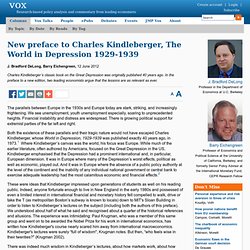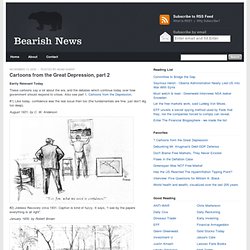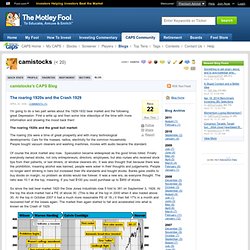

The World in Depression, 1929-1939 - Charles Poor Kindleberger. New preface to Charles Kindleberger, The World in Depression 1929-1939. J.

Bradford DeLong, Barry Eichengreen, 12 June 2012 The parallels between Europe in the 1930s and Europe today are stark, striking, and increasingly frightening. We see unemployment, youth unemployment especially, soaring to unprecedented heights. Financial instability and distress are widespread. There is growing political support for extremist parties of the far left and right. Both the existence of these parallels and their tragic nature would not have escaped Charles Kindleberger, whose World in Depression, 1929-1939 was published exactly 40 years ago, in 1973.1 Where Kindleberger’s canvas was the world, his focus was Europe.
These were ideas that Kindleberger impressed upon generations of students as well on his reading public. There was indeed much wisdom in Kindleberger’s lectures, about how markets work, about how they are managed, and especially about how they can go wrong. Summers was right. First, panic. In a sense, Kindleberger predicted all this in 1973. Joseph Stiglitz: “A Banking System is Supposed to Serve Society, Not the Other Way Around” What this transition meant, however, is that jobs and livelihoods on the farm were being destroyed.

Because of accelerating productivity, output was increasing faster than demand, and prices fell sharply. It was this, more than anything else, that led to rapidly declining incomes. Farmers then (like workers now) borrowed heavily to sustain living standards and production. Because neither the farmers nor their bankers anticipated the steepness of the price declines, a credit crunch quickly ensued. Farmers simply couldn’t pay back what they owed. The cities weren’t spared—far from it. The value of assets (such as homes) often declines when incomes do. Given the magnitude of the decline in farm income, it’s no wonder that the New Deal itself could not bring the country out of crisis. The Crash of 1929 & The Great Depression (PBS) 1of6. Political Cartoons from the Great Depression. Eerily Relevant Today These cartoons say a lot about the era, and the debates which continue today over how government should respond to crises.

Also see part 1, Cartoons from the Depression. #1) Like today, confidence was the real issue then too (the fundamentals are fine, just don’t dig too deep). August 1931, by C. W. . #2) Jobless Recovery circa 1931. January 1930, by Robert Brown #3) False “green shoots” in Fall of ’31 November 1931, by Robert Brown #4) 1933 – In a fit of insanity which lasted throughout much of the depression, the American government enacted the Agricultural Adjustment Act, which paid farmers to destroy food and plant less crops. June 1935, George Shellhase #5) Another critique of the AAA, this one from a leading black newspaper. May 1934, L. . #6) Broke but hoping. January 1931, by Ed Graham #7) Mixed signals. October 1931, John Cassel #8) Santa gets jacked. December 1931, Ralph Fuller #9) Depression-era critique of Keynesian economics.
February 1936, Robert Day. How the Depression Made Keynesians of Capitalists: Echoes. The Great Crash 1929: The classic account of financial disaster. Lords of Finance: 1929, The Great Depression, and the Bankers who Broke the World. The roaring 1920s and the Crash 1929. The roaring 1920s and the Crash 1929 April 20, 2008 – Comments (11) I'm going to do a two part series about the 1929-1932 bear market and the following great Depression.

First a write up and then some nice videoclips of the time with more information and showing the mood back then! The roaring 1920s and the great bull market: The roaring 20s were a time of great prosperity and with many technological developments. Of course the stock market also rose. So since the last bear market 1920 the Dow Jones Industrials rose 5 fold to 381 on September 3, 1929. Chart from djindexes.com who have a nice article with more details of the 1920-1929 bull market. The bear market 1929-1932: There were no real news that caused the crash. After that the market recovered until April 1930 when it reached 294. Chart from Millionaires became beggars, family fortunes were destroyed, the small investor lost everything. But enough words, here a nice 20 min. videoclip docummentary of the Crash 1929: Part 1 (4 min)